Summary: It was almost impossible for the temperatures seen recently in the Pacific North West heatwave to have occurred without global warming. And only improbable with it.
It’s been clear for at least a decade that global warming has been in general increasing the intensity of heat waves, with clear trends in observed maximum temperatures that match what climate models have been predicting. For the specific situation in the Pacific NorthWest at the end of June, we now have the first attribution analysis from the World Weather Attribution group – a consortium of climate experts from around the world working on extreme event attribution. Their preprint (Philip et al.) is available here.
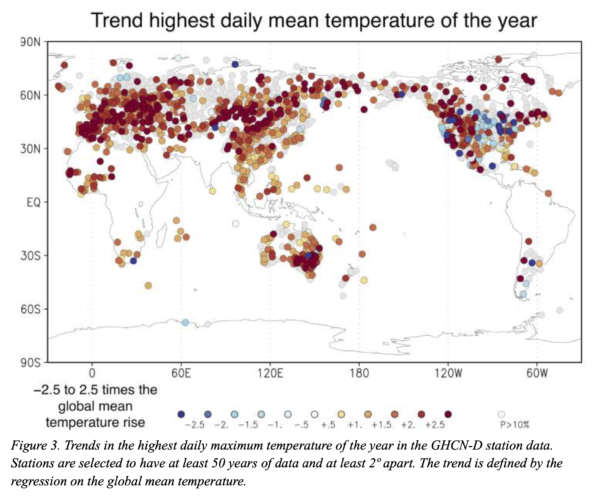
In the paper, they show that this event was truly exceptional in the temperature statistics in the region and specifically in Vancouver, Seattle and Portland, but that the geopotential height anomaly (one measure of the ‘heat dome’ or the ridging) was not that far off from the underlying trends. Using various methods to construct the return time for this event, they show that even in today’s climate this was a one in 400 yrs or longer event. Using only data from before 2021, an anomaly this large is estimated to never occur!
What happened?
Everyone is agreed that the specific synoptic situation is unusual. A large ‘omega’ pattern (so-called because of the resemblance to the Greek letter ![]() ) set up by a Rossby wave breaking event, intersecting with the topography and the warm temperatures to the south-west that were advected to the PNW. But the question is whether the temperature extremes are being made substantially more likely by underlying climate changes.
) set up by a Rossby wave breaking event, intersecting with the topography and the warm temperatures to the south-west that were advected to the PNW. But the question is whether the temperature extremes are being made substantially more likely by underlying climate changes.
First, look the maximum annual daily temperature in the region (according to the ERA5 reanalysis for the historical data and the actual weather forecast analyses since June 1st). There is a real trend of about 4ºC over the last 70 years – roughly 3 to 4 times the trend in the global mean temperature. Nonetheless, the magnitude of the regional anomaly is more than 5ºC above the previous record. That is, literally, phenomenal.
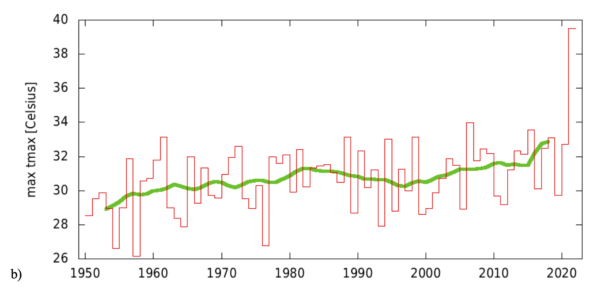
The temperature anomaly at the local station level is similarly huge at SeaTac airport, Portland International Airport and New Westminster (nr. Vancouver). Note that while the cities might be affected by urban heat island effects that would exacerbate the temperature signal, that would not affect the regional analysis above, nor the situation in village of Lytton, BC which set a massive new all-time Canada-wide temperature record on Tuesday June 29th and promptly burnt down a day later.
However, the situation is a little different if you look at the geopotential height anomalies – these are affected by the synoptic situation as well as the integrated temperature anomalies. In that case, while still record-breaking, the anomaly is not totally beyond expectations. Indeed, the trend in z500 values is similar to the situation in Western Europe last year.
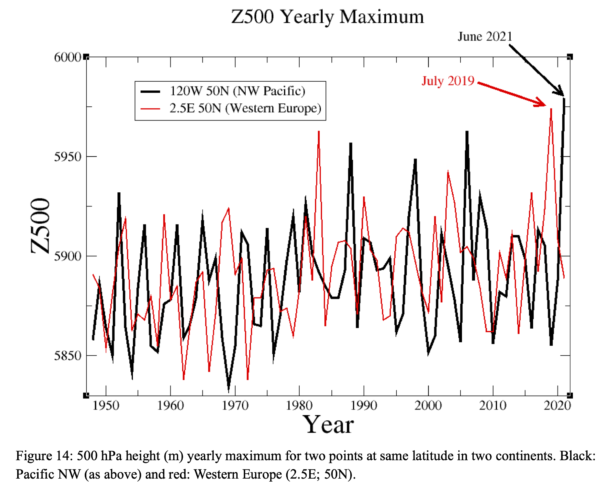
Together these analyses suggest a synoptic situation that is rare, but not inconceivable, but with temperature anomalies that are off the charts.
Attribution
The way that attribution for extreme events works (as discussed previously on RealClimate here and here etc.) is that you look at the situation with and without the anthropogenic global warming signal and calculate the ratio of probabilities. If an event is say, twice as common with the GW, then one can give a fractional attribution of 50% to anthropogenic forcing and the return time is half what it used to be. If it is five times more likely, the attribution is 80% = 100*(5-1)/5 and the return time is a fifth of what it used to be. In this case, we are seeing probability ratios of 150 to 1000s, suggesting that these, improbable, temperatures can be almost entirely attributed to global warming. Without the anthropogenic signal, temperatures this extreme wouldn’t have happened in thousands to tens of thousands of years.
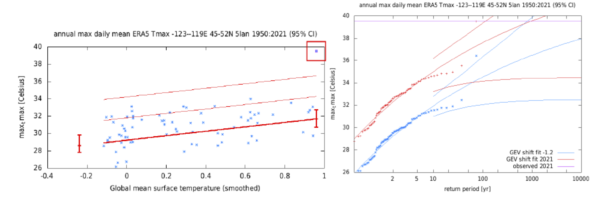
Rainfall and soil moisture deficits as a precursor?
In many previous extreme heat events, such as the 2003 European heatwave, rainfall deficits and dry soils the prior spring were shown to have made an important contribution to the temperature extremes, and so it’s worth looking at the same phenomena here. The IMERG data which are mostly based on satellite rainfall amounts do show a moderate deficit in the area over the last four months, but not so much of an effect that it could explain the anomaly on it’s own. The magnitude of this effect will be examined further in the months to come.
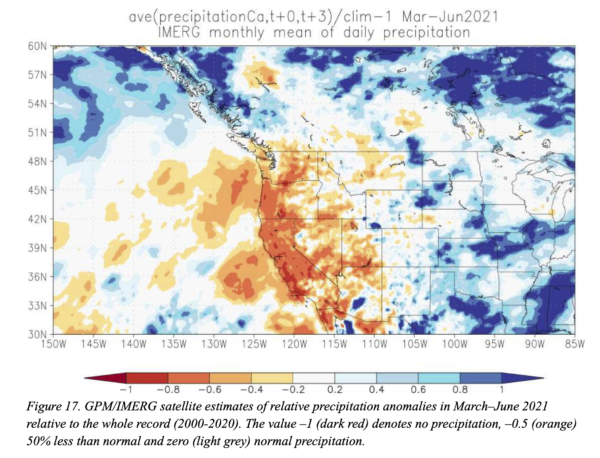
All models are wrong?
This kind of attribution is of course only as good as the models being used. In such a rapid attribution study, that means that the authors depend on an existing database – in this case, from CMIP5 and CMIP6 – and while they screen the models for fidelity in matching this genre of event, it’s possible that there are systematic issues with this class of model for a specific aspect of the situation. For instance, Mann et al., (2018) find that the CMIP5 models have a poor representation of a quasi-resonant (QR) phenomena in jet stream waves that are associated with the ‘omega’ pattern blocking event seen here. [Update: the specific claim in the paper relates to oscillations with wavenumber 6-8, while this event was more of a wavenumber 4 phenomena – see comment #9 below]. The expected trends in QR suggest an increase of about 30% in such events today over the situation in the pre-industrial. If models don’t capture this behaviour, it will make the event seem more unlikely than it really is. This might be resolved in higher resolution modeling specific to this event, but doesn’t really affect the broader conclusions.
Maybe it was just really, really, really unlikely?
Some people still reject these lines of argument, typical of this is Cliff Mass in this recent blog post. For them, the trends in max temperatures are (literally) ignored, and the fact that this phenomenon is being seen around the world is just a series of increasing unlikely combinations of factors that for some inexplicable reason keep happening. But this is really just a case of synoptic myopia – paying too much close attention to the series of specific events that lead to the specific situation, and not seeing the wood for the (burning) trees.
p.s. (8 July): In 2012 we published the highly relevant post Extremely hot, starting like this:
One claim frequently heard regarding extreme heat waves goes something like this: ”Since this heat wave broke the previous record by 5 °C, global warming can’t have much to do with it since that has been only 1 °C over the 20th century”. Here we explain why we find this logic doubly flawed.
Pretty much exactly what happened! And it ends thus:
So in summary: even in the most simple, linear case of a shift in the normal distribution, the probability for “outlandish” heat records increases greatly due to global warming. But the more outlandish a record is, the more would we suspect that non-linear feedbacks are at play – which could increase their likelihood even more.
References
- M.E. Mann, S. Rahmstorf, K. Kornhuber, B.A. Steinman, S.K. Miller, S. Petri, and D. Coumou, "Projected changes in persistent extreme summer weather events: The role of quasi-resonant amplification", Science Advances, vol. 4, 2018. http://dx.doi.org/10.1126/sciadv.aat3272
Folks… there is no upward trend in the number of record temperatures over the Northwest. That alone is pretty fatal to the claims. Furthermore, there is no viable amplifying mechanism for global warming over the region. In addition, several of the feedbacks are negative (easterlies weaken under global warming). PLEASE…not put downs and insults. Deal with these points!
This website was totally wrong about the snowpack issue. You are wrong about this as well…cliff
PS: the point take in the 500 hPa analysis was NOT in the center of the high and thus underplays how unusual the event was
PS2: Just because you get a large probability ratio DOES NOT mean that natural variability is not dominant or that a record breaking heat wave would not have happened without global warming. I explain this if it is not obvious.
@Cliff.
Let’s try some facts mixed with Logic.
No one, here nor in the attribution article (iirc), asserted that::
” a record breaking heat wave would not have happened without global warming.”
Now, Cliff, if you cannot see and know that yet, at this point in time, then logically it follows that you: ………………………………………
Please fill in that space with some self-awareness based on the hard evidence.
@Cliff
Point 1. “there is no upward trend in the number of record temperatures over the Northwest. “
That observation, be it true or false, is irrelevant to whether or not current global warming added to the extreme nature of the heatwave in the NW at this particular time.
The quantity of records being set over a short period of time is not the only (or key) arbiter (yardstick) for upward moving regional temperatures over time today, nor is such a stat a driver of heatwave events arising.
Nor do new records occurring (seemingly) suddenly and out of the blue decisive in determining whether or not cumulative global warming impacted or drove this particular heatwave to extreme record levels.
Raising this point about the recent number of “record temps”being set, is building a straw man, out of straw no less. Then setting fire to it and claiming you are right and everyone else is wrong. It does not follow, logically based on accumulated evidence and well known climate / weather processes in the real world.
TIP: Drop the obsessive certainty you are thinking logically about all the facts as they exist.
HINT: Cliff, you are making stuff up out of thin as you go.
AND Point 2: ” Furthermore, there is no viable amplifying mechanism for global warming over the region.”
If so, then that is really easy to prove beyond all doubt. Prove it – show your evidence and then logically explain what that evidence leads to.
Lastly Point 3: several of the feedbacks are negative (easterlies weaken under global warming).
I am confused now. Didn’t just assert there was no mechanism for regional global warming? I think you need to get really specific about what you mean and stop with the throw away lines and general assertions.
References: Got any?
I am not a meteorologist and yet I believe can think through this stuff logically with ease.
I have now Dealt with these points! without put downs and insults. Feel free to respond in kind, answer the questions, address my points, or don’t.
Reality Check: No one, here nor in the attribution article (iirc), asserted that::
” a record breaking heat wave would not have happened without global warming.”
RtW: I do. Without global warming it would be even odds that the high would have been below average. To time a what, 1000 year heatwave to the day? Low enough odds to simply reject unless accompanied by some sort of evidence.
Can anyone give me any evidence that a heatwave of any size at all would have occurred sans AGW?
@Richard.
That doesn’t matter what you have said now. Did you say this before to Cliff?
I was referring specifically to Cliff’s key argument. Being a strawman and fallacious vs scientific evidence based info and debate about that.
No one was arguing – ” a record breaking heat wave would not (could not) have happened without global warming. ”
That is not what the attribution report was about – they never claimed anything like that, nor did anyone here that I noticed until you, now, Cliff raised it. It’s a non-argument in my view.
My understanding was global warming impacts/effects now, today, ensured the heatwave was as intense, as high and extreme long lived as it was. Being a new record was not their main point. That it shattered records by such a huge amount was a major point.
Can anyone give me any evidence that a heatwave of any size at all would have occurred sans AGW? is asking the wrong question I think. That heatwaves have occurred with minimal GW in history and long before that seems sufficient evidence to me. GW logically makes such heatwaves more likely.
This has already been the case for at least 2 decades in some regions because that is what has been happening. But the attribution study and Cliff’s arguments are only about this one recent PNW regional event. I think his arguments are weak, and it seems the evidence in the attribution study far outweighs both Cliff’s arguments and his data/evidence he thinks supports them. This was my focus in my responses.
The huge heatwave in America in the 1930s was due to a rare combination of weather events, but such an event could not be infinitely hot. In a warmer world you can get the same weather conditions combining but you have added xyz degrees to the baseline temperature, so sooner or later we would have an event that could NOT have happened in the past few thousands of years.